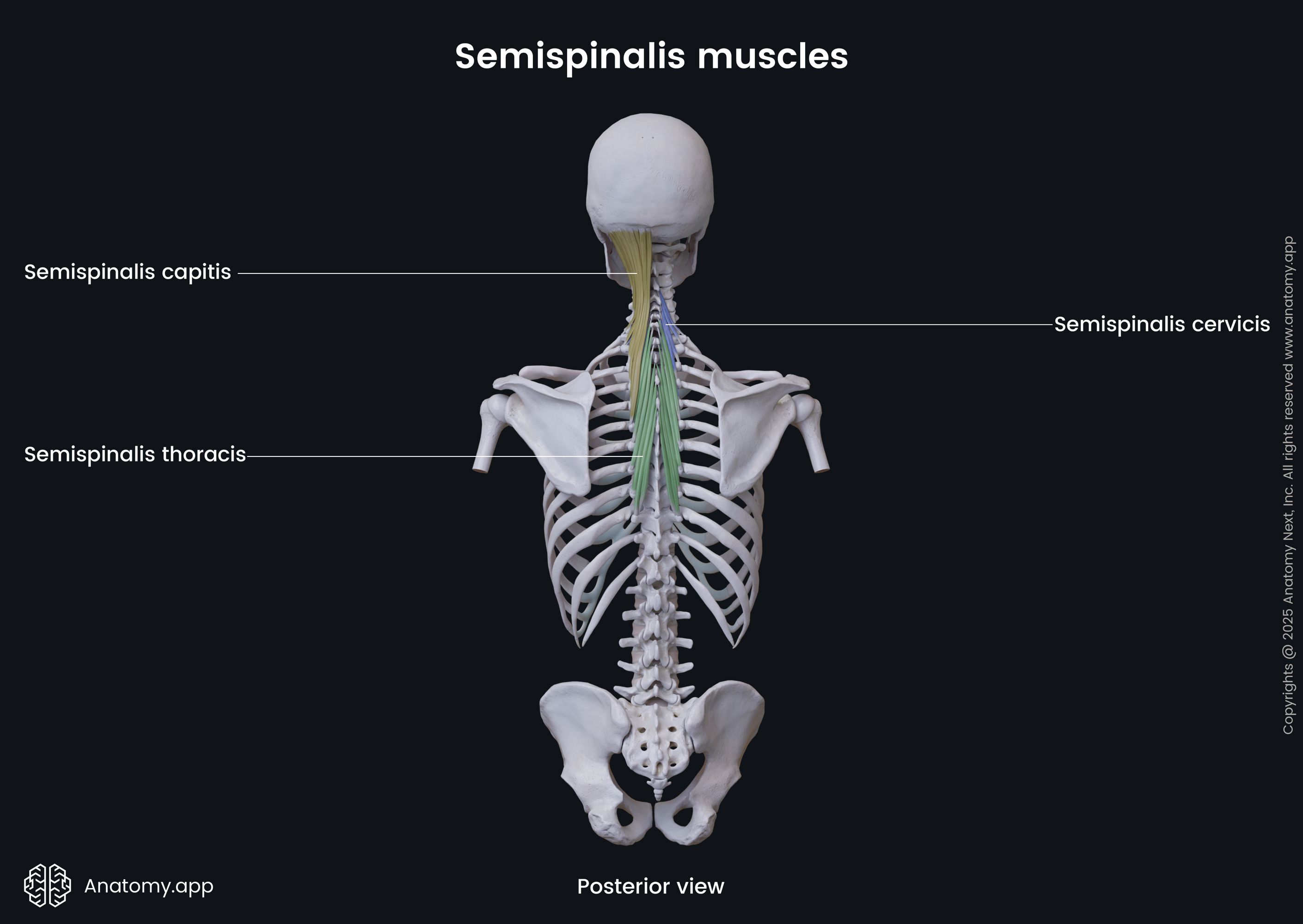- Anatomical terminology
- Skeletal system
- Joints
- Muscles
- Head muscles
- Neck muscles
- Muscles of upper limb
- Thoracic muscles
- Muscles of back
- Superficial back muscles
- Intermediate back muscles
- Deep back muscles
- Superficial layer
- Intermediate layer (Erector Spinae)
- Deep layer (Transversospinales)
- Deepest layer
- Muscles of lower limb
- Heart
- Blood vessels
- Lymphatic system
- Nervous system
- Respiratory system
- Digestive system
- Urinary system
- Female reproductive system
- Male reproductive system
- Endocrine glands
- Eye
- Ear
Semispinalis
The semispinalis muscle (Latin: musculus semispinalis) is the longest and most superficial set of muscles in the transversospinal group. Together with the multifidus and rotatores, the semispinalis muccle lies in the deep layer of the deep back muscles. It is located on either side of the spine and extends from the skull to the tenth thoracic vertebrae. The semispinalis muscles are subdivided into three portions based on their location. These portions include the semispinalis capitis, semispinalis cervicis and semispinalis thoracis.

The semispinalis capitis (Latin: musculus semispinalis capitis) is the most superior and longest part of the semispinalis muscles, and it overlies the semispinalis cervicis. The semispinalis cervicis (Latin: musculus semispinalis cervicis), also known as the semispinalis colli, is the middle portion of the semispinalis muscles. It lies over the cervical and thoracic parts of the multifidus. The semispinalis thoracis (Latin: musculus semispinalis thoracis) is the lower portion that overlies the thoracic multifidus.
Semispinalis capitis
| Semispinalis capitis | |
|---|---|
| Origin | Articular processes of C4 - C7 vertebrae, transverse processes of T1 - T6 vertebrae |
| Insertion | Occipital bone between superior and inferior nuchal lines |
| Action | Bilateral contractions - extension of head and neck Unilateral contractions - contralateral rotation of head and neck, ipsilateral lateral flexion of head and neck |
| Innervation | Descending branches of greater occipital nerve (C2), 3rd cervical spinal nerve (C3) |
| Blood supply | Occipital artery |
Origin
The muscle fibers of the semispinalis capitis arise from the articular processes of the fourth to seventh cervical vertebrae (C4 - C7) and from the transverse processes of the first to sixth thoracic vertebrae (T1 - T6).
Insertion
The semispinalis capitis inserts between the superior and inferior nuchal lines on the occipital bone.
Action
Muscle contractions on both sides (bilateral contractions) provide the extension of the head and neck. Contractions on one side (unilateral contractions) rotate the head and neck to the opposite side (contralateral) and laterally flex the head and neck to the same side of activation (ipsilateral).
Innervation
The semispinalis capitis muscle is innervated by the descending branches of the greater occipital nerve (C2) and the third cervical spinal nerve (C3).
Blood supply
The semispinalis capitis receives arterial blood supply from the occipital artery - a branch of the external carotid artery.
Semispinalis cervicis
| Semispinalis cervicis | |
|---|---|
| Origin | Transverse processes of T1 - T6 vertebrae |
| Insertion | Spinous processes of C2 - C5 vertebrae |
| Action | Bilateral contractions - extension of head and neck Unilateral contractions - contralateral rotation of head and neck, ipsilateral lateral flexion of head and neck |
| Innervation | Medial branches of dorsal rami of spinal nerves |
| Blood supply | Occipital, deep cervical and vertebral arteries |
Origin
The semispinalis cervicis muscle arises from the transverse processes of the first to sixth thoracic vertebrae (T1 - T6).
Insertion
The muscle fibers of the semispinalis cervicis insert on the spinous processes of the second to fifth cervical vertebrae (C2 - C5).
Action
Muscle contractions on both sides (bilateral contractions) provide the extension of the head and neck. Contractions on one side (unilateral contractions) rotate the head and neck to the opposite side (contralateral) and laterally flex the head and neck to the same side of activation (ipsilateral).
Innervation
The semispinalis cervicis muscle is innervated by the medial branches of the dorsal rami of the spinal nerves.
Blood supply
The semispinalis cervicis receives arterial blood supply from the occipital, deep cervical and vertebral arteries. The occipital artery is a branch of the external carotid artery, while the deep cervical artery arises from the costocervical trunk, and the vertebral artery branches off the subclavian artery.
Semispinalis thoracis
| Semispinalis thoracis | |
|---|---|
| Origin | Transverse processes of T6 - T10 vertebrae |
| Insertion | Spinous processes of C6 - T4 vertebrae |
| Action | Bilateral contractions - extension of head and neck Unilateral contractions - contralateral rotation of head and neck, ipsilateral lateral flexion of head and neck |
| Innervation | Medial branches of dorsal rami of spinal nerves |
| Blood supply | Dorsal branches of posterior intercostal arteries |
Origin
The semispinalis thoracis is composed of five thin muscle fascicles that arise from the transverse processes of the sixth to tenth thoracic vertebrae (T6 - T10).
Insertion
The semispinalis thoracis muscle inserts on the spinous processes of the sixth cervical to fourth thoracic vertebrae (C6 - T4).
Action
Muscle contractions on both sides (bilateral contractions) provide the extension of the head and neck. Contractions on one side (unilateral contractions) rotate the head and neck to the opposite side (contralateral) and laterally flex the head and neck to the same side of activation (ipsilateral).
Innervation
The semispinalis thoracis is innervated by the medial branches of the dorsal rami of the spinal nerves.
Bood supply
The semispinalis thoracis muscle receives arterial blood supply from the dorsal branches of the posterior intercostal arteries that arise from the superior intercostal arteries and thoracic aorta.